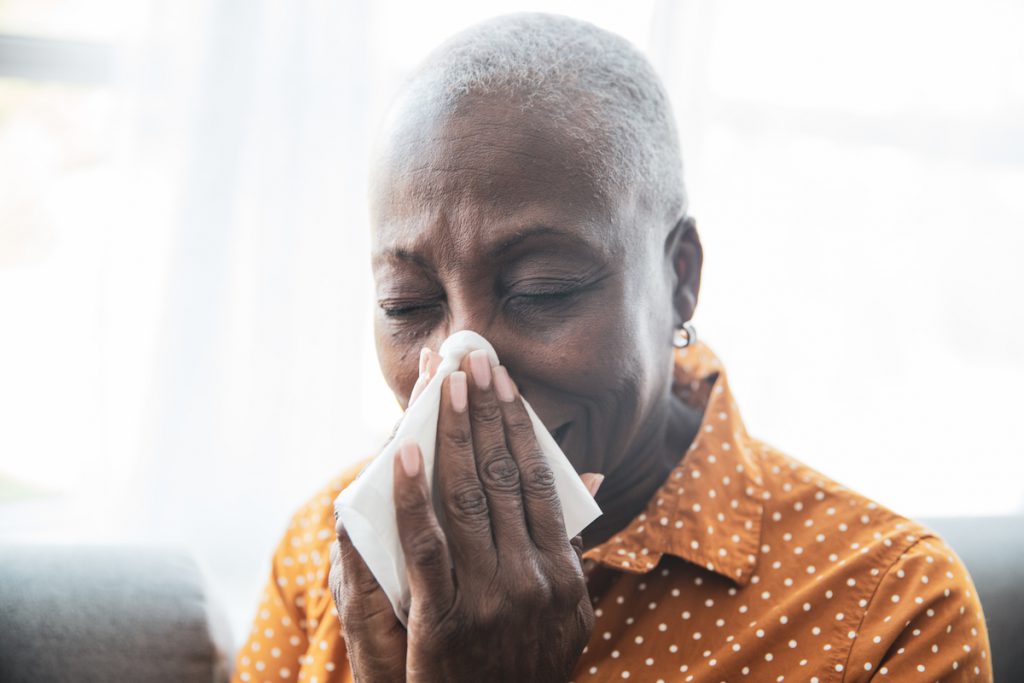7 Things to Know About Seasonal Allergies
Whether they’re mild or make you absolutely miserable, understanding your allergies can help you alleviate them.

Springtime means warmer weather, blooming flowers, and greener lawns. But for seasonal allergy sufferers, these simple pleasures come at a cost.
If you’re one of the 81 million people in the United States who experience allergic rhinitis (hayfever) each year, you’re certainly familiar with the symptoms—itchy throat, stinging eyes, and a nose like a faucet that just won’t stop.
Unfortunately, thanks to climate change, allergy season isn’t likely to let up any time soon. In fact, research shows that the season now starts about 20 days earlier and lasts 10 days longer than it did 30 years ago. Plus, pollen counts are up more than 20 percent.
If you or a loved one suffer from seasonal allergies, having a handle on the facts can help. Here’s what you need to know:
Add SilverSneakers to your wellness routine! Classes and events are happening right now at participating gyms, online through SilverSneakers LIVE, and at community centers near you. Activate your free online account to get started.
1. Allergies Are Caused by Our Bodies Overreacting
Allergic reactions occur when your body treats pollen — which is usually harmless — as a dangerous foreign invader. The body believes it needs to fight off the threat, which creates an inflammatory response. The body releases chemicals like histamines, which cause itchiness, redness, and swelling, as well as mucus in the nose, eyes, skin, throat, and ears.
2. The Triggers for Allergy Symptoms Are Different for Different People
We often think of seasonal allergies as a spring condition, but they can attack almost any time of year, depending on where you live and what sort of pollen or mold spores you’re allergic to.
Tree allergies typically appear in late winter through spring, grasses in late spring through summer, and weeds in late summer through early fall, according to John James, M.D., medical specialist and spokesperson for the Asthma and Allergy Foundation of America (AAFA).
Typical autumnal allergies can also be caused by plants like burning bush, pigweed, sagebrush, and mugwort. Depending on the climate where you live, these seasons can differ.
3. But the Symptoms Tend to Be the Same
No matter what sort of pollen you’re allergic to, the symptoms are typically pretty universal.
You’re likely to experience:
- Itchy, stuffy, or runny nose
- Red, itchy, or watery eyes
- Itchy mouth or skin
- Sneezing
- Ear infections
- Coughing
- Fatigue, which can be made even worse if your other allergy symptoms make sleep difficult
4. A Lot of What We Know About Seasonal Allergies Is Based on Studies in Children
In recent years, researchers have pointed out the need for more studies to closely look at the impact of aging and allergic responses. This includes reports in the journal Aging and Disease and in Current Allergy and Asthma Reports.
In the reports, the study authors noted that allergies are the most common autoimmune disease. They affect an estimated 10 to 30 percent of older adults. Allergies are also one of the fastest growing chronic conditions in people over the age of 15.
In older adults, allergy symptoms can sometimes mask other health problems — and vice versa. That’s why it’s important to not brush aside the onset of your symptoms. Well-managed allergies are indeed a quality of life issue.
5. It Might Be a Good Idea to Get Tested
Knowing your triggers can help you avoid them, and the best way to know for sure is to get tested. An allergist will go through your history and recommend either skin or blood testing.
Understanding which plants set off your symptoms can help your provider recommend appropriate treatment and help you lower your exposure — say, by removing a specific tree in your yard or using an air purifier at home.
Subscribe to our newsletter
It's quick and easy. You could be one of the 13 million people who are eligible.
Already a member? Click to discover our 15,000+ participating locations.
Follow Us
6. Prevention Is Often the Best Treatment
“Environmental control measures or avoidance of relevant allergens is an important step,” says Dr. James, who recommends a few simple measures:
- Stay indoors if possible when pollen counts are high.
- Take a shower and throw your clothes in the wash after being outside.
- Keep your windows closed and don’t use window fans during allergy season.
- Try not to exercise outside during the early morning or evening hours: Pollen counts are typically highest at these times.
- Wear a face mask outside as necessary.
- Avoid rubbing your eyes.
- Try a high-efficiency particulate air (HEPA) filter in your bedroom and clean floors with a vacuum equipped with a HEPA filter.
7. There Are Lots of Options to Help You Feel Better
There are a number of over-the-counter and prescription-strength options to treat seasonal allergies.
Common treatments include:
- Prescription topical nasal corticosteroid sprays, which Dr. James says are “the single most effective medication for treating seasonal allergies.”
- Second-generation antihistamines like Zyrtec/cetirizine, Claritin/loratadine, and Allergra/fexofenedine (all nondrowsy options).
- Saline rinses and nasal sprays, which can help with a runny nose.
- Allergy drops for itchy eyes.
If you take medication regularly for any condition, be sure to check with your doctor or pharmacist before taking an over-the-counter allergy medicine. That’s because some of the side effects of these medicines show up more often in older adults. You’ll also want to make sure that the OTC allergy medicine you choose doesn’t interfere with one of your regular medications.
See our sources:
Allergy facts and figures: Asthma and Allergy Foundation of America
Climate effects on health (allergens and pollen): Centers for Disease Control and Prevention
Allergy seasons and climate change: National Institute of Food and Agriculture
Common seasonal allergy triggers: American College of Allergy, Asthma, & Immunology
Allergies and aging: Aging and Disease
Allergic rhinitis in older adults: Current Allergy and Asthma Reports
Diagnosising allergies: American College of Allergy, Asthma, & Immunology
Activate Your FREE SilverSneakers Online Account
Get hundreds of free SilverSneakers On-Demand videos and stay in touch with us by creating your free online account. You don’t have to be a SilverSneakers member to get on-demand workout videos, health and fitness tips from SilverSneakers, and more.
SilverSneakers members can go to thousands of nationwide gyms and fitness locations, plus take SilverSneakers LIVE online classes led by specially trained instructors and designed for all fitness levels and abilities – at no additional cost. If you have a Medicare Advantage plan, it may include SilverSneakers. Check your eligibility here.
Already a member? Get your SilverSneakers member ID, search for locations near you, and all the health and wellness resources you need by logging in to your online member account here.





